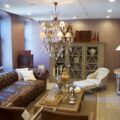In the realm of interior design, where aesthetics and ambiance play a pivotal role, the selection of colors is a cornerstone that holds the power to evoke emotions and set the tone for spaces. The Psychology of Color delves into the intricate relationship between hues and human emotions, offering a powerful tool for designers to craft spaces that resonate deeply with occupants. We understand the art of leveraging color to create spaces that not only please the eye but also evoke profound emotional responses.
The Influence of Color on Emotions
Colors are more than just visual stimuli; they have the remarkable ability to trigger an array of emotions and sensations. By understanding the emotional connotations associated with various colors, interior designers can transform spaces into immersive environments that cater to specific moods and purposes.
Calming Serenity with Blues
Blue, with its serene and tranquil undertones, is often associated with calmness and relaxation. Lighter shades like sky blue evoke a sense of openness and freedom, while deeper blues like navy can create an air of sophistication. In bedrooms and living spaces, a carefully balanced palette of blues can foster a soothing atmosphere, promoting peaceful retreats from the demands of daily life.
Energetic Vibrancy through Reds and Yellows
Reds and yellows are dynamic, attention-grabbing colors that inject energy into a space. Red, symbolizing passion and intensity, can be used as an accent color to stimulate conversations in social areas. On the other hand, yellow exudes warmth and positivity, making it an excellent choice for kitchens and dining spaces where conviviality and nourishment abound.
Earthy Grounding with Greens and Browns
Green is the color of nature, representing growth and renewal. Incorporating shades of green can infuse interiors with a sense of harmony and tranquility, perfect for spaces where relaxation and connection with the outdoors are desired. Browns, often associated with stability and comfort, can enhance this effect, evoking a grounded ambiance that resonates with the earth.
Pure Tranquility via Whites and Neutrals
Whites and neutrals hold a special place in interior design, offering a canvas of tranquility that allows other elements to shine. These colors symbolize purity, simplicity, and timelessness, making them a versatile choice for a wide range of spaces. From minimalist aesthetics to classical designs, whites and neutrals establish a serene backdrop that fosters clarity and balance.
Implementing the Psychology of Color in Interior Design
Mastering the art of palette selection for emotional impact involves a thoughtful integration of various colors, ensuring that they harmonize while effectively conveying the desired emotional ambiance. Our interior designers possess the expertise to create cohesive color schemes that resonate with the occupants on a profound level.
Understand the Space
Before embarking on the color selection journey, a comprehensive understanding of the space’s purpose and the emotions it should evoke is paramount. A bedroom, for instance, necessitates colors that promote relaxation and rest, while an office space could benefit from invigorating tones that enhance productivity.
Create a Color Hierarchy
Balancing and prioritizing colors is crucial to avoid overwhelming the senses. Establish a primary color and complementary secondary and tertiary colors that support the overarching emotional theme. This hierarchy maintains visual harmony while accentuating the desired emotions.
Consider Cultural Significance
Colors hold cultural significance and can elicit different emotions across diverse communities. It’s imperative to consider the cultural context of the space and its potential occupants when selecting a color palette. This ensures that the chosen colors are universally relatable and evoke the intended emotions.
Lighting Matters
Lighting has a profound impact on how colors are perceived. Natural and artificial lighting can alter the hues and intensities of colors, potentially influencing the emotional response they evoke. Designers take lighting conditions into account during color selection, ensuring that the desired emotional impact remains consistent regardless of the lighting environment.
Elevating Interior Spaces through the Psychology of Color
In the realm of interior design, colors are not just decorative elements; they are powerful tools that can shape experiences and emotions. We believe that harnessing the psychology of color is an art form that demands precision and insight. By creating spaces that evoke emotions through thoughtful palette selection, we craft environments that resonate with the human spirit and enrich lives.
If you’re seeking to transform your spaces into immersive havens that resonate with your emotions. Our team of skilled designers is dedicated to infusing the psychology of color into every facet of your interior design journey.
Very suitable Frequently Asked Question about Use Palette Selection for Emotional Impact in Interior Design
Opt for soft blues, greens, and neutrals.
Some, like blue for calmness and red for passion, are fairly universal.
Light, cool colors can help create a sense of space.
Lighting can dramatically impact how colors appear in a room.
Stick to a color scheme and balance warm and cool tones.
Conclusion
In the captivating world of interior design, the psychology of color holds the key to unlocking the full spectrum of human emotions. Through careful consideration and strategic palette selection, designers can create spaces that transcend the visual realm, resonating with occupants on a deeply emotional level. We are committed to employing the psychology of color to transform interiors into living, breathing works of art that inspire, soothe, and invigorate.


